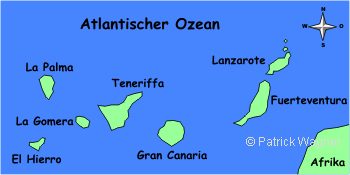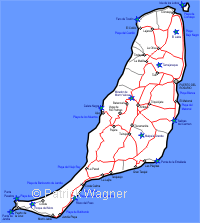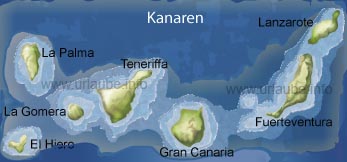|
|
|
General Information about Fuerteventura
Among the seven Canarian Islands, Fuerteventura is the island that mostly deserves the name bathing island; While the green islands as La Gomera or La Palma are oftenly described as the islands of eternal spring season, Lanzarote as the island with the most attractive volcanos, La Palma is also denominated as a hiking island and the big islands Tenerife and Gran Canaria are the dream paradises for many aged Germans, Fuerteventura is simply a bathing island where people like to fly to in order to enjoy the sun, beach and the sea. Most of the tourists fly to Fuerteventura in order to relax in one of the big holiday centres for one or two weeks on the beach or the hotel pool. Many tourists never leave the hotel complex, thus they do not make any excursions through the island; at the utmost they have a long walk on one of the long extended sandbeaches. And those visitors of the island who consider that an island viewing is a must during the visit of the island do not need to worry to get stressed. There are some sightseeings that people like to visit but that must not be necessarily visited. My travel report describes the most important sightseeings on three pages with a geographical focus on the north, the centre and the south of the island. Some Figures and Facts about the Island Fuerteventura
Those who are so lucky to get a seat at the right window side of the plane will already get a sightseeing tour from the air over Tenerife for free during the approach of the island. From above, the island appears to be flat and even; the eroded lava domes barely outstand from the plains and valleys. During our island tours, we certainly see some mountains, valleys and canyons, but compared to the other Canarian Islands, Fuerteventura is really very flat. The highest mountain in the south of the island, Pico de Zarza (Pico de Jandía), is only heighted 807 m. Thus, Fuerteventura is not very high, but therefore big: with a surface of approximately 1700 km², Fuerteventura is, after Tenerife, the second biggest Canarian island. The island measures 94 km in northerm-south direction and 28 km in east-western direction. On this huge surface, not even 100.000 people do live; Fuerteventura is the most sparsely populated Canarian Island. But therefore, there are the more tourists on the island: every year, millions of tourists spend their holiday in this bathing island. 
The biggest part of the tourists are spread in the three big tourist centres Corralejo, Costa Calma and Jandía. While Costa Calma and Jandía are firmly in the hand of the german tourists, in Corralejo at the north, there also are numerous English and Scandinavian tourists; As more than 60% of the vacationers are from Germany, the whole island is focused on the German audience. There is hardly a restaurant where one does not get a menue card in German language; most of the local people who found a job through the tourism also do speak some words in German, so that in Fuerteventura there is practically no need to take out one's fundamental knowledge of Spanish. The map shows that Fuerteventura is the Canarian Island that is the closest to the African continent: the distance to Africa is of only 100 km. This affects the climate insofar that during the year, it sometimes occurs that a heat wave from Africa arrives to the island and extends over the island as a fine carpet of sand from the Sahara. The political effect of this is that ships with refuges repeatedely try to get to the highly praised Europe illegally. Too oftenly the pictures of captured boats full of African refugees who arrive at the coast of Fuerteventura in a miserable condition, are shown on TV. The Origination of FuerteventuraFuerteventura is a volcano island; Everybody who only spent a bathing holiday in Fuerteventura will remind the numerous lava domes for a lifetime. The origination of the many volcanos with their partly mighty eruptions is mainly researched. But what is still not clear is the origination of the island, and/or of the whole Canarian archipielago. 
What is for sure is that the origination of the Canarian Islands has something to do with the drifting of the ozeanic, African and Eurasian tectonic plates. In the Mid-Atlantic Ridge (a tear of several kilometres length across the Atlantic Ocean) there is permanently coming magma out of the earth's interior, so that the Atlantic tectonic plate permanently enlarges. At the border area of the oceanic, African and Eurasian tectonic plate, the Atlantic plate broke and pushed some single fragments from the sea bottom to the surface. These fragments are forming the basis for the Canarian Islands. Lanzarote and Fuerteventura are located on such a fragment, thus they have practically the same basis. But these fundaments are not high enough to be recognized as an island over the sea level. The actual islands were originated by some massive submarine volcanic eruptions that spit out so many magma that they finally came out of the sea surface. By this way, the islands Lanzarote and Fuerteventura were originated approximately 20 million years ago. In western direction, the age of the Canarian Islands decreases: Gran Canaria was originated approximately 15 million years ago, Tenerife and La Gomera approximately 10 million years ago, and the youngest islands ln La Palma and El Hierro are not more than 1-2 million years old. In the course of millions of years, the island enlarged due to numerous volcanic eruptions. The resulting lava domes have today a round and flat form; made a big job. The most recent volcanic eruptions of the last tens of thousands years, created landscapes as the dune area El Jable or the small neighboured island Isla de Lobos. Malpaís (bad country), originated by the most recent volcanic eruption, can be still viewed today in the centre of the island. About the History of FuerteventuraThere are no aborigins of the island that can be documented by any kind of findings from the stone-age. During the first millenium before and after christ, the island was inhabitated by immigrants. From the 13th century, the European conquerors came to the Canarian Island on a regular basis; the main motivation for this was the slave trade; Numerous inhabitants were deported for slavery by the conqueror's ships. Up to the 15th century, two kingdoms existed in Fuerteventura: Maxorata at the north and Jandía at the south of the island. In the 15th century, Fuerteventura was, as also the other Canarian Islands, conquered by Spain. While the fertile islands La Palma, Gran Canaria and Tenerife were administrated straight by the Spanish queen Isabella, the dry islands Fuerteventura and Lanzarote were controlled and ruined by lords. The Spanish conquest meant, of course, the end of the local culture. The inhabitants of the island highly suffered by the lords, to whom they had to pay some high fees. The island was really exploited: trees were cut down in order to light the lime ovens. This former fertile land became bare and scant. It became increasingly difficult to carry out agriculture. Additionally, the inhabitants of the island suffered by the increasing attacks of the pirates. In the 17th century, many inhabitants escaped from the island so that not even 1000 were left over the pirates. In the 19th century, Fuerteventura became a free-trade area and in the beginning of the 19th century, the agriculture was again stimulated from Madrid. But the island does not experience a real boost until the 60ies, when the tourism slowly emerged. In the 80ies and 90ies, the peak of the building phase is reached and the government of the island decides to curtail the tourism boom in order not to completely sacrifice the own culture and the nature of the island for the touristical building madness. The tourism has certainly blemished numerous parts of the island with beton blocks, but beside jobs and money, it also provided many other positive aspects to the local people: the agriculture was again stimulated, thousands of goats provided milk and cheese that the tourists massively consume during their holidays. The fishermen returned to their old tradition, as the visitors of the island of course specially appreciated the local and recently caught fish. And also the handcraft, specially the embroidery, experienced a kind of rennaissance, as many tourists bought local products as souvenirs or gifts. 
Back to the index Fuerteventura Copyright: Patrick Wagner, www.tourist-guide.biz |
||